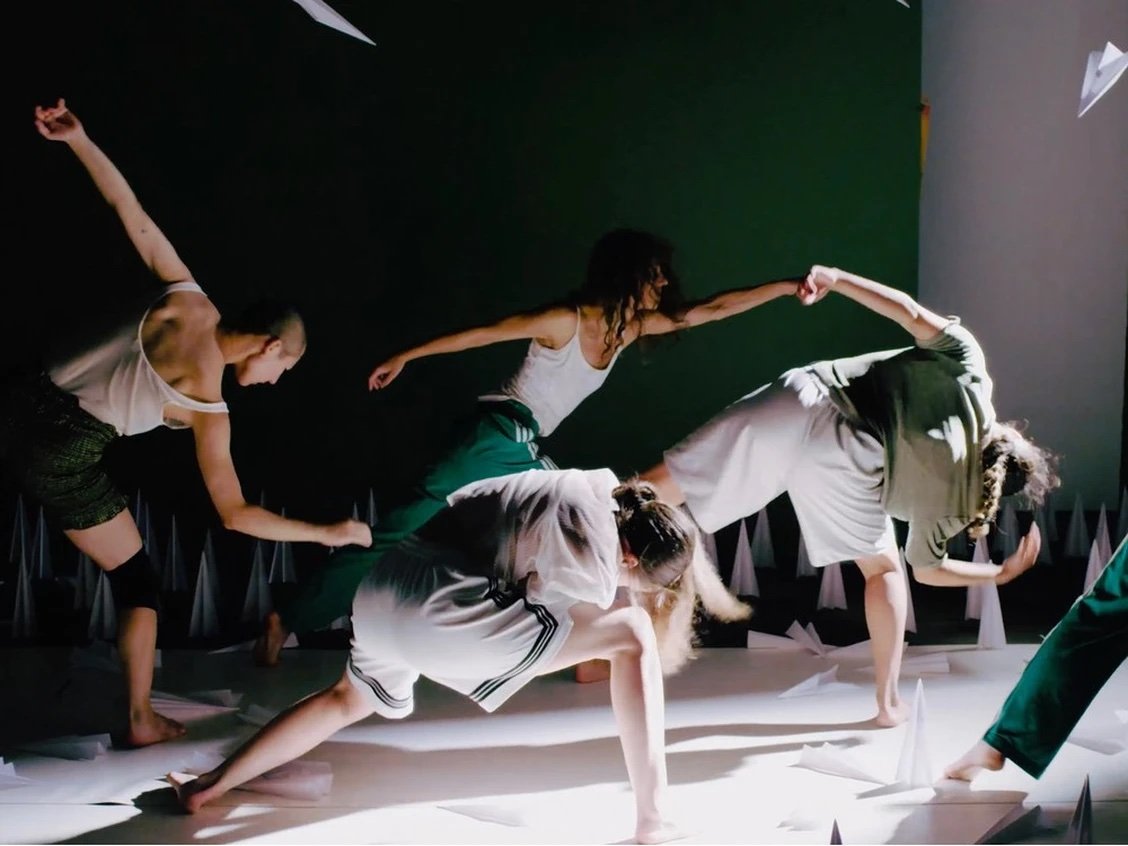Dance review: Paper Mountains conjures an apocalyptic realm of paradoxes
World premiere from choreographer Anya Saugstad is full of powerful vignettes and contrasting elements

Paper Mountains. Photo by Bray Jorstad
Anya Saugstad’s Paper Mountains was at the Scotiabank Dance Centre on November 23 as part of The Dance Centre’s annual Dance In Vancouver series
PARADOXES ARE AT the centre of Anya Saugstad’s Paper Mountains, which had its world premiere as part of Dance In Vancouver this past weekend.
At several points throughout the piece, dancers collapse on the floor motionless, and then reach assuredly for the sky with energy stretching out through their fingertips. Elsewhere, their movements are slow and sinewy as arms scoop through the air and curve into circles, but later become sharp to form boxy shapes. We see that rest can result in motion, and strength can yield softness. These contradicting ideas play into an overarching theme of evolution that choreographer Saugstad has really nailed in Paper Mountains.
Several interesting visuals are created through costuming (which is by Saugstad) and lighting (courtesy Andie Lloyd). Dancers Eowynn Enquist, Nasiv Sall, Oksana Maslechko, Sarah Hutton, and Shion Skye Carter wear fully sequinned tanks, shorts, and dresses in silver, black, red, and pink—looking like dazzling starlets, which provides a drastic contrast with their surroundings. There’s a thick fog that blankets the stage throughout the show, conjuring an apocalyptic atmosphere with warm spotlights that reflect off the shimmering outfits. Elongated shadows appear beneath the haze. Though unsettling at times, these design choices feel fitting for the concept at hand.
The soundtrack by musicians Stefan Nazarevich and Amanda Sum adds effectively to that imagery. A deep, rolling thunderclap often reverberates around the theatre, paired with a build-up of crackling that brings to mind embers and electricity. Then there’s Sum’s light and ethereal humming, cutting through the gloom with delicate power.
Saugstad began choreographing Paper Mountains during the pandemic, which feels evident in lots of the piece’s partner work. Though there isn’t much physical contact, the performers do a good job of connecting with each other in space, mirroring pushes and pulls from a distance.
Because the movement here alternates so swiftly between floor-bound and upward-reaching, the dancers could use a bit more grounding to hold themselves stable (there are a couple shaky single-leg balances during the first half of the piece). But the floorwork in particular is silky smooth, with fluid rolls, slides, and transitions.
The tableaux vivants created throughout the piece are also really impactful. In one instance, the dancers freeze with their hands raised to shield their eyes from the spotlight glaring down at them. With their scintillating outfits and unwavering stances, they deliver a captivating moment.
A bit of quiet solace comes when fake snow begins to drift down from the rafters. It seems to bring comfort despite all the chaos that has come before—yet another paradox. With its ever-evolving imagery and contrasting textures, Paper Mountains has an endless amount of layers and nuances to offer. ![]()
Stir editorial assistant Emily Lyth is a Vancouver-based writer and editor who graduated from Langara College’s Journalism program. Her decade of dance training and passion for all things food-related are the foundation of her love for telling arts, culture, and community stories.
Related Articles
Company 605 and T.H.E Dance Company push cross-Pacific team of dancers to embody a society rushing toward the next thing, at the Scotiabank Dance Centre
The Dust Palace’s cabaret send-up stars a visionary fashion designer who sews costumes live onstage at The Cultch
Canadian-Brazilian interdisciplinary artist brings together film and dance in a work that can be enjoyed from different angles at the Roundhouse
Marco Goecke, Crystal Pite, Sharon Eyal, and Fernando Magadan provide a whirlwind of short work for tomorrow’s next dance stars
Presented with Boca del Lupo, the accessible production by the U.K.’s Seven Circles encourages interactive learning
Aussie troupe Gravity & Other Myths’ stripped-down spectacle has been a hit around the world
Senior dance artists offer decades of insight to the new event’s joyful collaborations with younger performers
Bobbi Jene Smith and Or Schraiber share a full-evening work, and hit productions of Crystal Pite’s Frontier and Shahar Binyamini’s BOLERO X return
In the midst of an international career, the Kidd Pivot dancer is setting a short Crystal Pite work for the student showcase
Moroccan and Spanish choreographers join the international contingent of event that runs at Firehall Arts Centre and SFU Woodward’s
With the Vancouver Latin American Cultural Centre, artists Marco Esccer and Carla Alcántara celebrate the centenary of the feminist writer’s birth
Powerful dancing across the board in Medhi Walerski’s striking Last light; Bobbi Jene Smith and Or Schraiber’s straight-from-the-heart Obsidian; and Marco Goecke’s vibrating Woke Up Blind
As part of Asian Heritage Month, the gallery’s first performers-in-residence use old-school radios and headlamps in a new piece that fuses dance, multimedia, and theatre
The Dance Centre prizes carry $5,000 in funding for each artist
Fifth edition of uncurated program provides a welcoming space for artist’s first dance-theatre piece
Tickets on sale today for a Simran Sachar–Justine A. Chambers choreographic collab, comedian Kiran Deol, and Indian classical music star Alam Khan
Batsheva Dance Company alumni’s fascinating journey around the globe and onscreen finally brings them to Vancouver with Obsidian
In a surreal and outstanding conclusion to the DanceHouse season, the Belgian company warps time and gravity, toying inventively with cinematic tropes
Vancouver Playhouse performances feature choreography by Crystal Pite, Marco Goecke, Sharon Eyal, and more
New Works hosts screenings, while the Dance Centre presents performances by the likes of Vanessa Goodman, Dance//Novella, and Lesley Telford
Ashvini Sundaram takes second place in prize presented by The Hawthorne Foundation and DanceHouse























